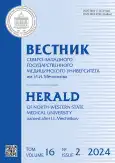The effect of Streptococcus mutans, Candida albicans and other cariesogenic factors on the concentration of cathelicidin LL-37 in oral fluid in children with early childhood caries
- Authors: Reutskaya K.V.1, Satygo E.A.1
-
Affiliations:
- North-Western State Medical University named after I.I. Mechnikov
- Issue: Vol 16, No 2 (2024)
- Pages: 43-48
- Section: Original study article
- Submitted: 17.02.2024
- Accepted: 11.03.2024
- Published: 03.07.2024
- URL: https://journals.eco-vector.com/vszgmu/article/view/627108
- DOI: https://doi.org/10.17816/mechnikov627108
- ID: 627108
Cite item
Abstract
BACKGROUND: Human antimicrobial peptides play a significant role in innate immunity. In the oral cavity salivary glands and mucosal epithelium produce human antimicrobial peptides, including defensins and cathelicidin LL-37. Cathelicidin is the most significant peptide protecting against different types of infections, controls the activity of commensal bacteria and prevents colonization and growth of pathogenic bacteria.
AIM: To determine the concentration of cathelicidin LL-37 in the oral fluid of children 2–5 years old and the oral hygiene index depending on some of the parameters and intensity of the carious process in the oral cavity.
MATERIALS AND METHODS: The study was conducted in a group of children aged 2-5 years old; the concentration of catelicidine in the oral fluid was determined by enzyme immunoassay. Moreover, the concentration of Streptococcus mutans in saliva, the presence of Candida albicans in dental plaque, oral hygiene index and the concentration of 25-hydroxycalciferol in venous blood were assessed in these children.
RESULTS: The stydy revealed the dependence of the concentration of cathelicidin in the oral fluid on the intensity of the carious process in children as well as on the concentration of Streptococcus mutans in saliva, the presence of Candida albicans in plaque and poor oral hygiene.
CONCLUSIONS: It was found that in children with high intensity of caries, the concentration of antimicrobial peptide LL-37 is twice lower than in children with low and medium intensity of early childhood caries.
Full Text
About the authors
Karina V. Reutskaya
North-Western State Medical University named after I.I. Mechnikov
Email: Reut_kv@mail.ru
ORCID iD: 0000-0001-9319-1077
SPIN-code: 2930-3317
MD, Assistant of the Department
Russian Federation, Saint PetersburgElena A. Satygo
North-Western State Medical University named after I.I. Mechnikov
Author for correspondence.
Email: stom9@yandex.ru
ORCID iD: 0000-0001-9801-503X
SPIN-code: 8776-0513
MD, Dr. Sci. (Med.), Professor
Russian Federation, Saint PetersburgReferences
- Anil S, Anand PS. Early childhood caries: prevalence, risk factors, and prevention. Front Pediatr. 2017;5:157. doi: 10.3389/fped.2017.00157
- Xiao J, Huang X, Alkhers N, et al. Candida albicans and early childhood caries: a systematic review and meta-analysis. Caries Res. 2018;52:102–112. doi: 10.1159/000481833
- Zhang W, Li Y, Lin J, et al. Cariogenicity of Candida albicans of distinct genotypes among 3-5-year-old Uygur children in Kashgar, China – a case-control study. BMC Oral Health. 2018;18(1):203. doi: 10.1186/s12903-018-0658-4
- Kim HE, Liu Y, Dhall A, et al. Synergism of streptococcus mutans and candida albicans reinforces biofilm maturation and acidogenicity in saliva: an in vitro study. Front Cell Infect Microbiol. 2021;10:623980. doi: 10.3389/fcimb.2020.623980
- Almoudi MM, Hussein AS, Abu-Hassan MI, et al. The association of early childhood caries with salivary antimicrobial peptide ll37 and mutans streptococci. J Clin Pediatr Dent. 2021;45(5):330–336. doi: 10.17796/1053-4625-45.5.7
- Tao R, Jurevic RJ, Coulton KK, et al. Salivary antimicrobial peptide expression and dental caries experience in children. Antimicrob Agents Chemother. 2005;49(9):3883–3888. doi: 10.1128/AAC.49.9.3883-3888.2005
- Ouhara K, Komatsuzawa H, Yamada S, et al. Susceptibilities of periodonto- pathogenic and cariogenic bacteria to antibacterial peptides, {beta}-defensins and LL37, produced by human epithelial cells. J Antimicrob Chemother. 2005;55(6):888–896. doi: 10.1093/jас/dki103
- Dale BA, Tao R, Kimball JR, Jurevic RJ. Oral antimicrobial peptides and biological control of caries. BMC Oral Health. 2006;6 Suppl 1(Suppl 1):S13. doi: 10.1186/1472-6831-6-S1-S13
- Vavilova TP, Derkacheva NI, Ostrovskaia IG. Antimicrobial peptides – the multifunctional protection of the tissues of the oral cavity. Russian Stomatology. 2015;8(3):3–12. EDN: VHVNHF doi: 10.17116/rosstomat2015833-12
- Liu PT, Stenger S, Li H, et al. Toll-like receptor triggering of a vitamin D-mediated human antimicrobial response. Science. 2006;311(5768):1770–1773. doi: 10.1126/science.1123933
- Youssef DA, Miller CW, El-Abbassi AM, et al. Antimicrobial implications of vitamin D. Dermatoendocrinol. 2011;3(4):220–229. doi: 10.4161/derm.3.4.15027
- Davidopoulou S, Diza E, Menexes G, Kalfas S. Salivary concentration of the antimicrobial peptide LL-37 in children. Arch Oral Biol. 2012;57(7):865–869. doi: 10.1016/j.archoralbio.2012.01.008
- Colombo NH, Ribas LFF, Pereira JA, et al. Antimicrobial peptides in saliva of children with severe early childhood caries. Arch Oral Biol. 2016;69:40–46. doi: 10.1016/j.archoralbio.2016.05.009
- Gyll J, Ridell K, Öhlund I, et al. Vitamin D status and dental caries in healthy Swedish children. Nutr J. 2018;17(1):11. doi: 10.1186/s12937-018-0318-1
- Satygo EA, Goncharova OV. Analysis of the leading pathogenetic factors of dental caries in children with celiac disease. Stomatology. 2020;99(3):71–73. EDN: ZPNZYI doi: 10.17116/stomat20209903171
- Razina IN, Chesnokova MG, Nedoseko VB. The Relevance of Candida spp. in chronic periodontal disease. Stomatology. 2017;96(4):4–6. EDN: ZENRUP doi: 10.17116/stomat20179644-6
Supplementary files







